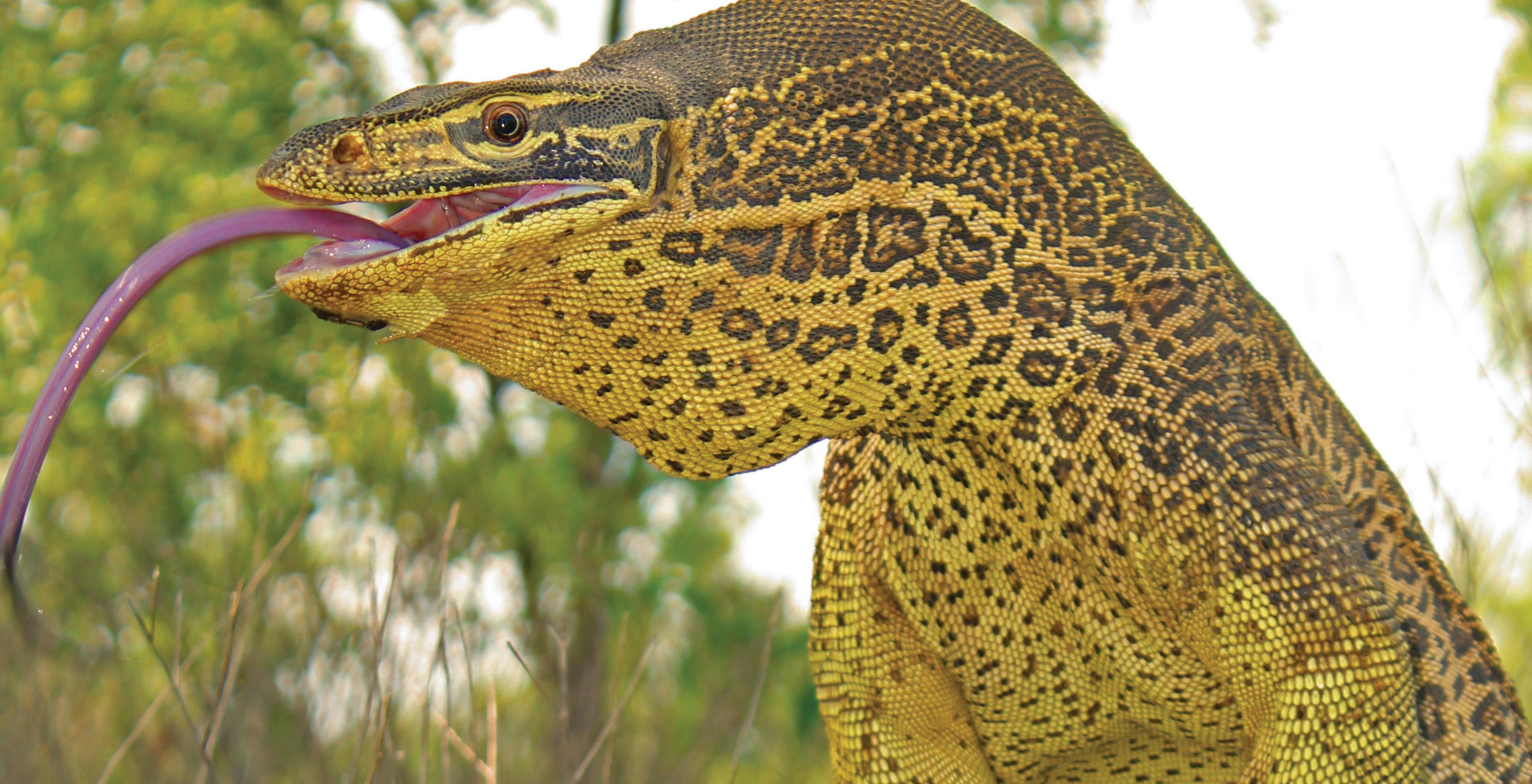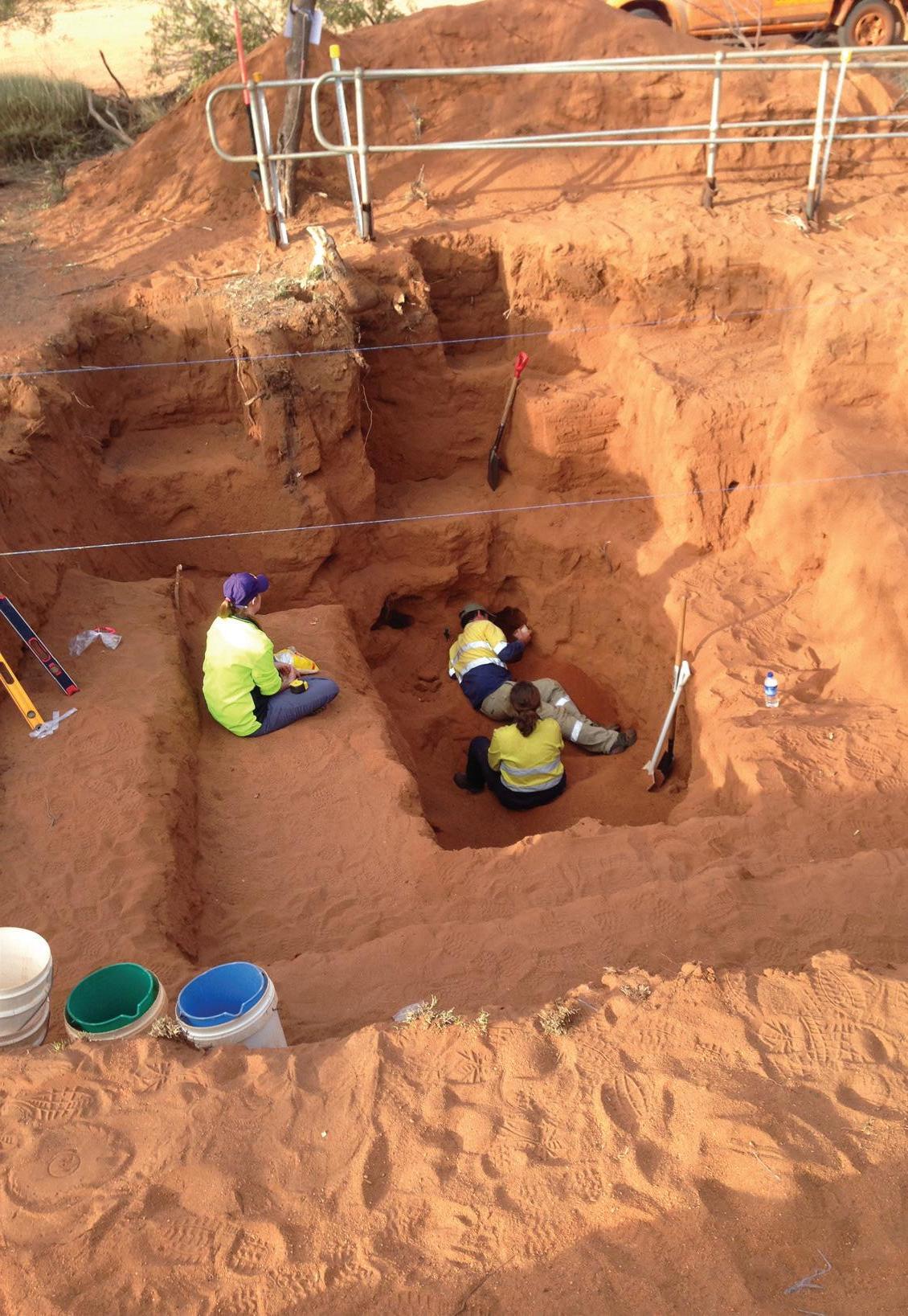
8 minute read
COMPLEX LIVES OF REPTILES
COMPLEX LIVES OF REPTILES
BIOLOGIST UNCOVERS THE NESTING HABITS AND COMPLEX SOCIAL LIVES OF REPTILES
Advertisement
Sarah Sell
Growing up in Louisiana, Sean Doody loved to explore the woods and catch animals, especially amphibians and reptiles. He would return muddy and bring whatever creatures he found inside the house to study them.
“I used to come home with these giant salamanders that I found in ditches. They look like an eel with tiny feet. I used to bring them home and keep them in an aquarium and feed them worms and things. Visitors either found them really cool or really gross,” Doody said.
His fascination with herpetology eventually led to a career in conservation biology. Now an assistant professor and graduate director of integrative biology at the USF St. Petersburg campus, Doody’s work has taken him halfway around the world to study poisonous toads and giant lizards.
The ten years of research led by Doody recently revealed that the monitor lizard in Australia should be regarded as an “ecosystem engineer,” a rarity for reptiles.
Tortoises and sea turtles were previously the only reptiles considered to be ecosystem engineers, a term used to describe organisms that have a great impact on their environment based on their ability to create, modify, maintain or destroy a habitat.
Doody, along with his colleagues, discovered that in Australia, small animal communities rely on the monitor lizards’ burrow system, called a warren, using it as a habitat, a place to forage for food and nesting.
In his study, published in Ecology, Doody and his Australian collaborators investigated the nesting biology of the yellow-spotted monitor lizard, which can measure nearly five feet, and its smaller, sister species, the Gould’s monitor lizard. The team had recently discovered that the lizards are unique because they lay their eggs as deep as 13 feet, easily the deepest vertebrate nests on earth. They loosen the soil, creating warm, moist conditions ideal for laying eggs and trapping viable seeds and fruits. But now, the researchers have discovered that the burrows hosted a wide range of animals, including reptiles, frogs, insects and even marsupial mammals. The team found 747 individual species of 28 types of vertebrates.

Sean Doody, assistant professor and graduate director of integrative biology at the USF St. Petersburg campus, studies the nesting biology of monitor lizards in Australia.
The timing of the research revealed clues as to why certain species utilized the warrens. For example, throughout the winter dry season, the researchers found hibernating frogs using the burrows to maintain their body moisture. During one excavation, Doody and his team discovered 418 individual frogs in a single warren.
“The finding is significant as it shows that nesting warrens provide critical shelter and other resources for the small animal community,” Doody said. “The invasive cane toad is decimating the monitor lizards in some areas, meaning that these nesting warrens, which are re-used year after year, will disappear. This can impact the relative number of predators and prey, which can have unexpected consequences for the ecosystem, such as an overabundance of one species at the cost of another, which in other systems has threatened species with local extinction.”
The arrival of the toxic cane toad underscored the extent of the monitor lizard’s impact on the food web. In studies conducted between 2009 and 2017, Doody’s research team uncovered abandoned burrows and an increase in the lizard’s prey, including smaller lizards, snakes, turtles and birds. Australian researchers and natural resource managers have been unable to successfully control cane toads.
Doody is now expanding his research to include the perentie, another large monitor lizard that likely nests at great depths in the Australian desert, to see if it too should be deemed an ecological engineer.
In June 2021, Doody also co-authored a book that combined his current research with classic studies to highlight the secret social lives of reptiles.


Small animal communities rely on the monitor lizards’ burrow system, called a warren, using it as a habitat, a place to forage for food and nesting.
“We have to be able to understand them to protect them,” explained Doody.
The cold-blooded, scaly creatures are often thought of as solitary, uncaring or asocial. In reality, experts believe they communicate extensively with one another and hunt, feed, court, mate, nest and hatch in groups.
The largely unknown and extensive social lives of these animals is the premise of the new book “The Secret Social Lives of Reptiles,” by Doody, Vladimir Dinets and Gordon M. Burghardt, three of the world’s leading experts on reptiles.
The book brings together several decades of research from around the world that details the mysterious social lives of non-avian reptiles, including turtles, crocodilians, lizards, snakes and the tuatara, a rare reptile resembling a lizard that is only found in New Zealand. One of the many fascinating pieces of research detailed in the book is Doody’s field research involving the monitor lizard.
The three authors have a shared conviction that social behavior in reptiles has been vastly underappreciated. Doody added that they wanted to create a showpiece for the scientific community.
“We tried to read every paper on reptile social behavior. So many of the studies are people painstakingly watching, radio tracking, following and discovering evidence of social behaviors in snakes, turtles and lizards around the world. Personally, I had started to study types of social behavior in reptiles, particularly communal nesting in reptiles, how mothers exchange social information and where they put their eggs,” Doody said.
We talked with Doody about his new book and why he thinks people, especially students, should know about the social lives of reptiles.
WHY WAS IT IMPORTANT FOR YOU AND YOUR COLLEAGUES TO WRITE THIS BOOK?
We were discussing how everyone is dismissive that reptiles engage in social behavior because they can’t compare to mammals, birds and some insects like ants. But they can be highly complex socially. So there ended up being a dichotomy where you’ve got your mammals and birds, which are highly social, and then reptiles are being pigeonholed as non-social when that simply wasn’t the case. Also, if we understand how social behavior evolves, we need to understand its fundamental, rudimentary origins. How did it become what it is, complex in mammals and birds, from a reptilian type of ancestor? Understanding the evolution of social behavior requires that we understand it in groups like reptiles.
If you’re a student interested in the social behavior of animals, you’re going to be drawn to mammals and birds because the reptiles are dismissed as asocial, so you’re not going to go there. A bias builds up. They don’t know that reptiles are social. We fully realized how little we know about the behavior of reptiles. This book serves to say we need to get back out there and figure things out. We’ve got a lot of extinctions; biodiversity is on the decline and we’re losing species before we even know what they do or did.
WHAT ARE SOME EXAMPLES OF SOCIAL BEHAVIORS IN REPTILES?
Male crocodiles babysit hundreds, sometimes thousands of babies that aren’t even their own. So, you have babies on the back of a dad cruising around the lake. A colleague of mine works on this. It’s very unusual to protect young that aren’t even yours, even in things like mammals. It’s a very extraordinary social behavior for any animal. They’ve discovered that the younger males are tasked with this, and those younger males aren’t even getting to mate, so it looks like it’s a ritual that the young males go through protecting the babies. Then, as they get older, they get to mate with the females. Social behavior can also include courtship, fighting, combat between males for females and any interaction between the same species. For example, one couple of lizards have been meeting every year for 27 years to mate. The sleepy lizard in Australia is seasonally monogamous, so males and females meet and hang out for a few weeks, mate and go their separate ways the rest of the year.
WHAT CAN WE DO TO PROTECT THESE REPTILES?
We have several major problems driving biodiversity down. Habitat loss is the big one. We keep clearing woods and putting in homes and shopping centers. We’ve got an increasing population right here in Florida, and that doesn’t help.
The other is climate change. A lot of people are talking about it. Not too much has happened yet, but it’s is starting to happen. Our grandkids and their kids are going to be in for some surprises.
Invasive species are also a problem. Florida is one of the worst in the world because of the pet trade. A lot of exotic species are released, like the pythons in the everglades. We also have over-exploitation—for example, rhino horns, elephant tusks and over-harvesting animals for food.
Those are the things we need to work on to stem the tide. We’re going to have to make some compromises or keep losing species.

Doody and his research team looking for nests in an excavation pit in Australia.










